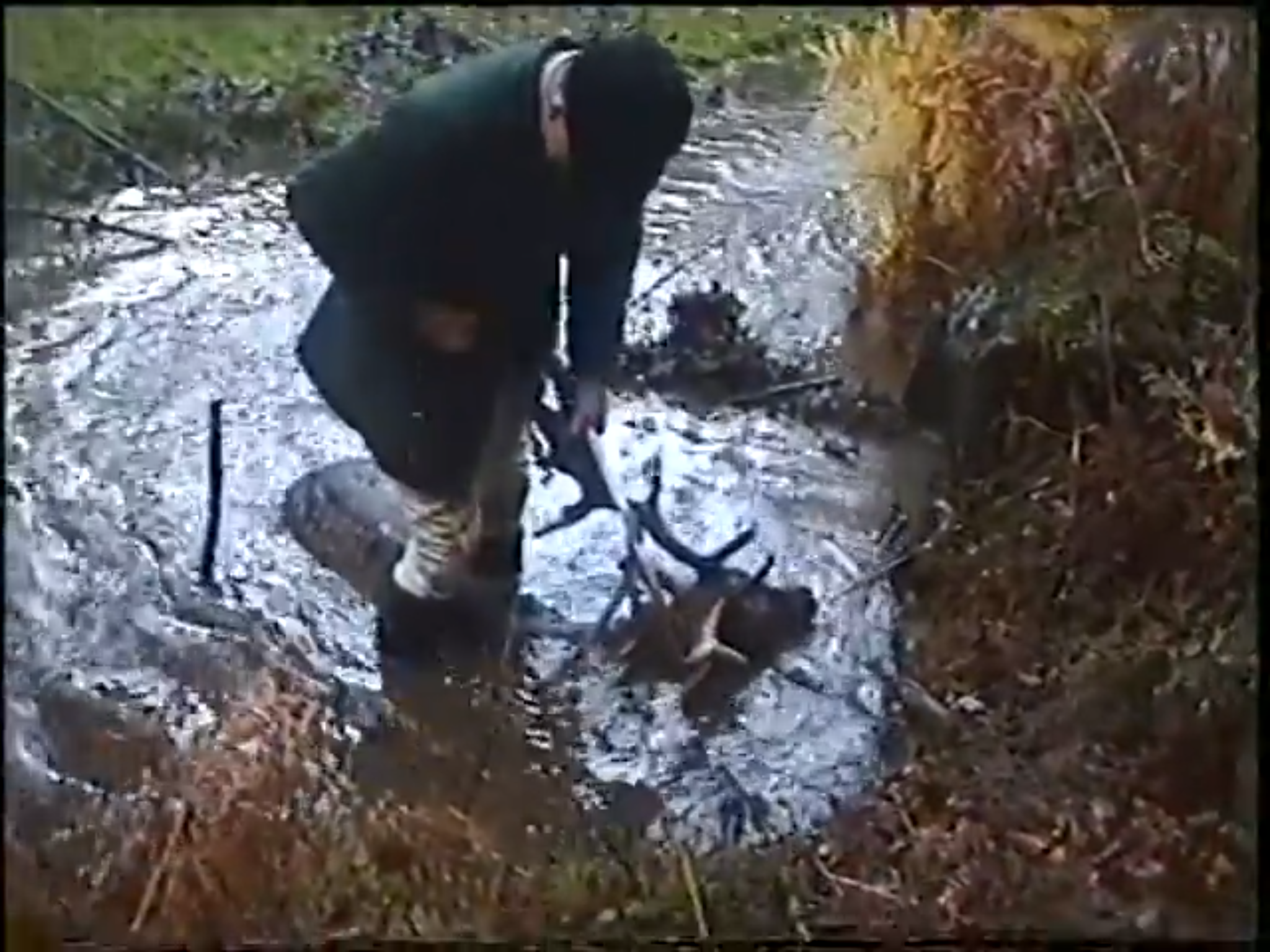13th December 2018
Hunting Myths Pt 6: Hunting Is Wildlife Management
 Pest Control, wildlife management or simply a cruel sport which made some money & satisfied the bestial urges of a sadistic minority? Here, now defunct New Forest Buckhounds Huntsman John Stride fumbles in his pocket for a gun whilst straddling an exhausted fallow buck run to collapse in a stream. Stills from a film taken in 1995 by Wildlife Action.
Pest Control, wildlife management or simply a cruel sport which made some money & satisfied the bestial urges of a sadistic minority? Here, now defunct New Forest Buckhounds Huntsman John Stride fumbles in his pocket for a gun whilst straddling an exhausted fallow buck run to collapse in a stream. Stills from a film taken in 1995 by Wildlife Action.
Zoologist Jordi Casamitjana writes exclusively for Hounds Off
Perhaps the claim that wild animals need to be lethally managed by people is the most crucial false argument Mr Barrington uses in his rhetoric (Horse & Hound, 11.10.18). He always tries to get others to accept this claim before he then moves with the claim that ‘if they need to be killed, better do it with dogs’. But the truth is that in most cases, wildlife doesn’t need to be managed. In most cases, natural ecosystems (and the wildlife in them) need to be preserved by preventing humans’ interference and letting Nature to find its own balance. And in the cases where Nature needs a helping hand because we humans have messed the ecosystem too much, there are plenty of feasible wildlife management methods that are not lethal, and therefore are not based on killing wildlife (such as fencing, shepherding, translocations, management of available food, deterrents, etc.).
Unfortunately this dangerous idea that killing is necessary to succeed is very much entrenched in the minds of many landowners, from farmers killing wildlife around their land to protect their ‘products’, to shooting estates eliminating predators of the animals they want to sell as live targets for the guns, to conservation organisations obsessed with the preservation of a particular species and wanting to kill other animals that compete with them.
As such, non-lethal methods of wildlife management are often ignored and unnecessary killing is chosen when it should have been avoided. This accounts for the examples Mr Barrington uses in the article, which he uses as either examples of compulsion (‘it needs to be done’) or hypocrisy ( ‘we have to do it but we want to keep it secret’), as if somehow validates such practices. These examples of Mr Barrington’s lethal ideas are so dangerous that even some organisations which should be protecting animals are unfortunately (and erroneously) seduced by them, causing much unnecessary suffering and death.
In the case of foxes it is particularly true that they don’t need lethal control, as a lot of research has already proven that the fox population is not growing out of control, and their ‘negative’ effect on farming has been greatly exaggerated. Research has already shown how little foxes contribute to lamb predation and that it is likely that when a shepherd finds evidence of a fox eating a lamb this may be because the lamb died from other causes. The fox is just being a scavenger.
And foxes who take advantage of poor human husbandry by getting into henhouses do not kill more than they can eat at one sitting for the sheer fun of it. ‘Surplus killing’, as it is known, is a survival technique which has evolved in foxes to guard against future food shortages.
Fox populations self-regulate because they are composed by territorial animals, so the populations are kept more or less stable if the space and food availability does not change. And if there is a problem with a particular fox, killing it may make it worse. If farmers remove an older fox with any lethal wildlife management method because they consider this fox ‘vermin’ another young fox will replace it very soon after as the territory become vacant and no longer defended by the older fox. This new fox is most likely to be more ‘problematic’ to farming as it is likely to be more inexperienced and not know the territory well, venturing more into places it is not welcomed (the areas where livestock are kept), and thus making the ‘problem’ even worse.
In Mr Barrington‘s article it is claimed that hunting provides a huge level of controlled public access to private land, but everyone who has attempted to monitor hunting knows how false this is. It is precisely the fact hunts these days use much private land which the public are not allowed to enter which allows them to hunt illegally with impunity, as it is difficult to obtain evidence without such access. Hunt supporters don’t hesitate to prevent public access to rights of way and common land because they fear that anyone who does not belong to their fraternity may end up reporting them to the authorities when they witness what they actually do.
From blocking roads with their vehicles to physically assaulting bystanders, the hunting fraternity is well known for their intimidation and violent tactics towards the general public, so this claim is quite ludicrous.
© Jordi Casamitjana
Zoologist
PREVIOUSLY
Hunting Myths Pt 1: The Snakeoil Salesman
Hunting Myths Pt 2: They Only Go For The Sick Old & Weak
Hunting Myths Pt 3: Hunting Is Efficient & Humane
Hunting Myths Pt 4: Hunting Is Natural
Hunting Myths Pt 5: Hunting Conserves The Countryside
0 Comments | Be the first to comment >

